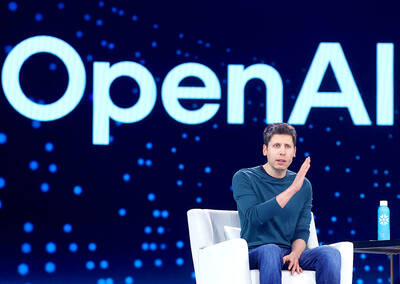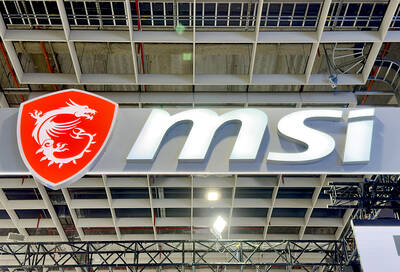Chartered Semiconductor Manu-facturing Ltd, the world's fourth-largest supplier of made-to-order chips, may add to growing evidence of a recovery in semiconductor demand when it briefs investors tomorrow, analysts said.
The Singapore-based company's shares have risen more than a quarter in the past month, outpacing gains by bigger rivals, Taiwan Semiconductor Manufacturing Co (TSMC, 台積電), up 12 percent, and United Microelectronics Corp (UMC, 聯電), which has gained 9 percent.
Chartered Semiconductor, which has posted nine consecutive quarterly losses, has been winning orders as its rivals fill up capacity at their most advanced plants, forcing some customers to look elsewhere, analysts said. Demand for chips used in cell phones and computers is climbing as telecom companies start high-speed mobile services and after Intel Corp introduced a new wireless product for notebook computers earlier this year.
"They probably will raise at least their near-term forecast" for sales, said Russell Tan, an analyst with NRA Capital, who rates the shares "hold."
Chartered Semiconductor's shares, which fell 83 percent last year, rose S$0.035to S$0.0915 as of 10:33am, after hitting a low of S$0.63 on March 31. They touched a high of S$16.03 in March 2000.
Taiwan Semiconductor shares rose NT$3 to NT$56.50. United Microelectronics shares rose NT$1.50 to NT$23.30.
The company, which in March predicted that it would have a second-quarter loss of US$97 million to US$107 million on sales of US$114 million to US$120 million, will provide its mid-quarterupdate this morning in Singapore.
Chartered Semiconductor is gaining from the spillover at Taiwan Semiconductor and may be winning new customers at its less-advanced factories, analysts said.
Taiwan Semiconductor, the world's biggest supplier of made-to-order chips, said last week it expects sales this year to rise by 20 percent, aided by demand for its most sophisticated production equipment.
It forecast in April that its second-quarter factory use would rise to 80 percent from 67 percent in the first three months.
Demand for chips is coming from makers of cellphones with color screens and from makers of devices that let computer users surf the Internet wirelessly, said Lim Chuan-yang, an analyst with Standard & Poor's.
Some analysts have questioned whether the recovery cam be
sustained.
Chip companies also gained steam in the middle of last year before demand fell below analysts' forecasts at the end of the year.
As a result, chip sales overall barely rose last year.
"There is some concern among investors about whether we'll see a similar pattern this year," said Pranab Kumar Sarmah, an analyst with Daiwa Institute of Research.
Chartered Semiconductor, which is about 60 percent owned by a Singapore government agency, has put off adding the latest chip-making systems to conserve cash as it looks to improve activity at its older factories, where business has been sluggish.
The company has used less than half of its chip-making equipment since the first quarter of 2001.
Its second and third-oldest factories, known as Fab 2 and Fab 3, can produce a combined 63,000 chip wafers a month, according to the company's regulatory filings.
Last year, their total output was 243,000 wafers, or an average of 20,250 a month.

DIVIDED VIEWS: Although the Fed agreed on holding rates steady, some officials see no rate cuts for this year, while 10 policymakers foresee two or more cuts There are a lot of unknowns about the outlook for the economy and interest rates, but US Federal Reserve Chair Jerome Powell signaled at least one thing seems certain: Higher prices are coming. Fed policymakers voted unanimously to hold interest rates steady at a range of 4.25 percent to 4.50 percent for a fourth straight meeting on Wednesday, as they await clarity on whether tariffs would leave a one-time or more lasting mark on inflation. Powell said it is still unclear how much of the bill would fall on the shoulders of consumers, but he expects to learn more about tariffs

Meta Platforms Inc offered US$100 million bonuses to OpenAI employees in an unsuccessful bid to poach the ChatGPT maker’s talent and strengthen its own generative artificial intelligence (AI) teams, OpenAI CEO Sam Altman has said. Facebook’s parent company — a competitor of OpenAI — also offered “giant” annual salaries exceeding US$100 million to OpenAI staffers, Altman said in an interview on the Uncapped with Jack Altman podcast released on Tuesday. “It is crazy,” Sam Altman told his brother Jack in the interview. “I’m really happy that at least so far none of our best people have decided to take them

PLANS: MSI is also planning to upgrade its service center in the Netherlands Micro-Star International Co (MSI, 微星) yesterday said it plans to set up a server assembly line at its Poland service center this year at the earliest. The computer and peripherals manufacturer expects that the new server assembly line would shorten transportation times in shipments to European countries, a company spokesperson told the Taipei Times by telephone. MSI manufactures motherboards, graphics cards, notebook computers, servers, optical storage devices and communication devices. The company operates plants in Taiwan and China, and runs a global network of service centers. The company is also considering upgrading its service center in the Netherlands into a

NOT JUSTIFIED: The bank’s governor said there would only be a rate cut if inflation falls below 1.5% and economic conditions deteriorate, which have not been detected The central bank yesterday kept its key interest rates unchanged for a fifth consecutive quarter, aligning with market expectations, while slightly lowering its inflation outlook amid signs of cooling price pressures. The move came after the US Federal Reserve held rates steady overnight, despite pressure from US President Donald Trump to cut borrowing costs. Central bank board members unanimously voted to maintain the discount rate at 2 percent, the secured loan rate at 2.375 percent and the overnight lending rate at 4.25 percent. “We consider the policy decision appropriate, although it suggests tightening leaning after factoring in slackening inflation and stable GDP growth,”